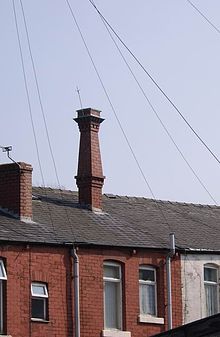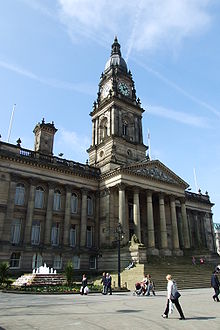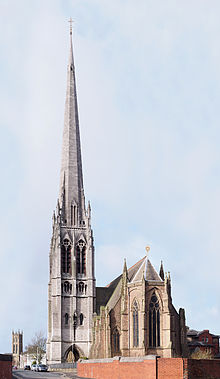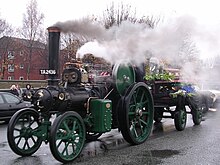Fred Dibnah
Frederick "Fred" Dibnah MBE (born April 28, 1938 in Bolton , Lancashire ; † November 6, 2004 ibid) was an English chimney builder and a television presenter for technology history programs. He brought down 90 chimneys without the aid of explosives.
Live and act
Childhood and youth
Fred Dibnah was the son of Frank and Betsy Dibnah, nee Travis, who initially worked in a chemical plant. He grew up in the industrial city of Bolton and was already enthusiastic about the machines and industrial buildings there as a child.
At school, he focused on art, as his reading and writing skills were assessed as poor, and then went to an art college for three years, where his works dealt with machines, coal mines and weaving mills.
Dibnah has been observing chimney builders, known in England as steeplejack , since he was a child and saw the first flipping of a chimney from his father's allotment near the Bolton dog racing area in Raikes Park. The demolition company first removed the top half of the chimney and then punched a hole in its base that was supported with wooden braces. These struts were then destroyed by fire, causing the chimney to collapse. Unfortunately, on that occasion, the chimney fell the wrong way onto the dog kennels at the racecourse, onto a café, and onto a power line.
At the age of 17 or 18, he climbed an 80 m high chimney in Barrow Bridge because of a bet for 10 shillings and attached two Union Jack flags to the lightning rod. The Bolton Evening News reported the incident with a photo but assumed it was a prank by students at nearby Manchester University .
At the same time, Dibnah decided to replace the chimney on his mother's house in Alfred Street with a self-designed one because his mother only used one of the four trains. Since the opening at the top was only about 10 cm in diameter, it had to be cleaned regularly. One day when Dibnah lowered a sack filled with bricks on a line for sweeping chimneys down the chimney, the sack tore open and several lead water pipes were destroyed, so that the maternal kitchen was flooded. The house was sold after the mother's death and the chimney was listed as a historical monument.
At the age of 22, Dibnah was drafted for military service in Aldershot and Catterick , where he worked in the kitchen. With the cavalry regiment of the 14th / 20th King's Hussars he was sent to the Federal Republic of Germany , where he took over building maintenance activities at his request.
Chimney demolition
After returning from military service, Dibnah took his tools from the warehouse in 1962, bought an old AJS motorcycle with 350 cm³ from 1927 for 21 guineas and looked for orders.
Bolton was affected by a post-industrial decline at this time: from 1957 to 1965, seventy textile factories were closed and partially demolished, so that there were only 37 operational textile factories in addition to 50 closed ones. Dibnah kept afloat doing odd jobs until he could buy his own ladders and repair a chimney at a local brewery. While doing so, he met a welder who informed Dibnah that the Vicar of Bolton was placing a repair contract for the Bolton Church weather vanes. Dibnah received the assignment that was reported in the local press. He made friends with the vicar during this project, which also led to follow-up orders on other church towers.
During his chimney repairs, Dibnah noticed the need to demolish chimneys. He offered the explosive-free method he observed in Bolton and became known nationwide for it. In the course of his professional life he has knocked down a total of 90 chimneys.
First marriage
After disagreements about who should be invited to the wedding, Dibnah and 19-year-old hairdresser Alison Mary Foster traveled to Gretna Green in 1967 to get married. Dibnah had seen Alison from the top of a chimney for the first time, and met again later in a pub. They got engaged six weeks later. They left letters for their parents and took the train to Carlisle and from there buses to Dumfries . They had to live there for at least 21 days to be able to get married there, and Dibnah decided to dispose of the ridge of a hotel for board and lodging. On May 19, 1967, the two married in Gretna Green Church and then returned to Dibnah's mother's house. They later moved to a Victorian gatehouse on the Earl of Bradford's grounds just outside Bolton. Dibnah renovated the building over several years and built an extension. The couple later bought the house for £ 5,000 although further repairs were required to stabilize the back wall.
Their first daughter, Jayne, was born in June 1968. Alison was initially concerned about her husband's occupational risk, but learned to deal with and trust him. She took over the bookkeeping and took care of the accounts receivable.
Steam engines
Dibnah has been interested in steam engines and steam locomotives since childhood and rode on locomotives in the driver's cab from an early age. He bought his own locomobile near Warrington , originally owned by Flintshire County Council, for £ 175 and put it back into service. At the same time, he also bought a construction trailer which he restored so that he could take his family to local steam engine meetings.
His next purchase was a 1912 Aveling & Porter steamroller for £ 2,300 in the fall of 1980 . He built a steam engine-powered workshop in his backyard, reusing various items discarded by textile mills, including a steam engine from the Oldham textile mill. The steamroller was auctioned in July 2010 for £ 240,000.
In 1988 he carried out repair work on the chimney of Glynllifon on behalf of the Caernarfon municipal administration . Below the chimney stood a dilapidated single-cylinder steam engine from 1854. Dibnah brought it to Bolton for repairs in the winter of 1988/89. Together with his colleague Neil Carney, he worked on the repair for 6 months and eventually won an award for the quality of the work. A little later, within 7 months, he repaired the steam engine and clay mixer at the Wetheriggs County Pottery near Penrith , Cumbria .
Television documentary
In 1978, Dibnah carried out repairs on the 16 pillars of the Bolton Town Hall bell tower. While he was working high up in his boatswain's chair, the City Hall press secretary informed him that BBC Look North West wanted to interview him. The following week the camera crew arrived and Alistair MacDonald conducted the interview from the top floor of the building while Dibnah worked outside on the scaffolding. His simple and open manner, along with his enthusiasm and broad Lancashire dialect, quickly made him popular, and as a result, producer Don Haworth asked him if he would like to do a documentary show. Filming began at the top of the 75 m high chimney in Shaw and Crompton , a textile factory town near Oldham . The film work dragged on at irregular intervals over 18 months and showed Dibnah with his assistant Donald Paiton on numerous buildings, in family surroundings and in his hobbies. One of the most impressive moments was the fall of the Rochdale Chimney in 1979, when Dibnah stood meters from the base of the chimney and did not retreat until it was beginning to sway. His youthful exclamation “Did you like that? - Did you like that? “Made him popular with the audience.
Fred Dibnah, Steeplejack won the BAFTA Award for Best Documentary in 1979 , and Haworth has come back several times to make additional documentaries.
A few years later, Dibnah and his family were filmed while on a vacation trip to Blackpool where Dibnah couldn't stop working. Together with his wife Alison, he put down a small chimney on a local company. Since he could not be persuaded to take another vacation trip, his wife booked a trip to Greece for himself and the three children Jayne, Lorna and Caroline. Dibnah stayed at home and was surprised when she filed for divorce from their 18-year-old marriage on return. In October 1985, Dibnah returned from a charcoal and briquette exhibition in Bury to find Alison had left the house with the kids, dog, and some furnishings. Since he was short of cash, he had to sell his beloved AJS motorcycle classic. He found life without a family difficult, but defended them because the pressure had simply become too great for them.
Second marriage
Dibnah met his second wife Susan (Sue) Lorenz, a 28-year-old secretary, at a steam engine rally in Cheshire. He later invited her to pull a chimney in Oldham and then to a lecture for his fans in Halifax, West Yorkshire , who met under the name The Fred Dibnah Appreciation Society. He married her on February 27, 1987; he grew a beard for her and gave up smoking. He had two sons with her, Roger and Jack.
Age
In 1996 Dibnah repaired the 80 m high chimney in Barrow Bridge, which he had decorated with flags as a teenager for the bet, and set up a nest for peregrine falcons there. He then campaigned for the chimney to be listed as a historical monument. As a remarkable narrator, he was increasingly invited to formal events as an after-dinner speaker , wearing his characteristic flat cap with a tuxedo.
His eccentric activities put strain on the marriage, and after Susan met another man, she moved out with her son Roger, but left her son Jack with Dibnah.
Third marriage
In 1997 Dibnah lived alone with little work and a low income. Sheila Grundy, a former wizard's assistant, visited him with her parents and son to see the backyard of Dibnah. She moved in with him in 1998 and married him on September 26, 1998.
TV moderation
The author David Hall predicted in 1997 that Dibnah would not be hired for further television documentaries in the future and suggested that he switch to television moderation. The two developed a concept for a program in which Dibnah drove across the country on the steam tractor to visit important historical sites and to talk to the men who took care of the maintenance of industrial machines and buildings. Filming for Fred Dibnah's Industrial Age began in July 1998 and was completed in the fall of 1998.
Although Dibnah found it more nerve-wracking to speak in front of a camera than to bring down a chimney, success was inevitable: the series achieved high ratings and positive reviews. The associated BBC website had the second highest number of visitors to the station at the time. The companion book made it to number 5 of the history book bestsellers of this year.
He also presented other series, such as Fred Dibnah's Magnificent Monuments , and had his signature red ladders attached to St Walburg's Church in Preston for an inspection prior to the filming . But since the filming took more time than planned, he was unable to complete the inspection assignment. He left the ladders at the church for several years and finally gave them to the craftsman who took the job in his place.
On the centenary of Queen Victoria's death, the BBC broadcast a program presented by Dibnah, Fred Dibnah's Victorian Heroes , for which he visited the Clifton Suspension Bridge, built by Isambard Kingdom Brunel , and the dock of the SS Great Eastern .
illness
Shortly before the shooting of Fred Dibnah's Building of Britain began at the beginning of 2001, Dibnah suffered from severe abdominal pain and had to be examined in the hospital. After his release, he filmed various landmarks such as the Globe Theater , Ely Cathedral and Glamis Castle, as well as an episode on the UK canal network as Chairman of the Manchester Bolton & Bury Canal Society. At the end of the shoot, Dibnah went to Bolton Royal Hospital for a follow-up exam and found a malignant tumor on his right kidney. An examination at Christie Hospital in Manchester found additional tumors on his bladder, which were successfully treated with chemotherapy .
Filming for Fred Dibnah's Age of Steam began in 2003 at the Trencherfield Mill at Wigan Pier . The film crew visited several locations including a steam engine rally in Cornwall and the Bluebell Railway in Sussex . The restoration of his steam engine was nearly complete by this point, but a check-up at Christie Hospital found a new, large tumor on his bladder.
Dig with Dibnah
After another chemotherapy, this time unsuccessful, Dibnah began to build a replica of the winding tower of a coal mine in the back yard of his property. He received planning permission for the headframe without mentioning that he wanted to build a 30 m deep brick-lined shaft underneath. At the foot of the shaft, a horizontal tunnel with a narrow-gauge railway was to lead into the deep gorge at the edge of his garden, from where a funicular should have brought the trucks back to the headframe. In 2003 the BBC began filming the shaft under construction and in various coal mines and mining museums. Using traditional mining methods, his friends, Alf Molyneux and Jimmy Crooks, who used to work in the mining industry, sank a 6 m deep shaft and lined it with bricks. Since Dibnah had not applied for a building permit for this, the municipal administration insisted that he should subsequently submit a building application, which was not approved despite an appeal.
Fred Dibnahs Made in Britain
At the end of 2003 he began filming Fred Dibnah's Made in Britain . With his companion Alf Molyneux, Dibnah toured the country on his now completed steam tractor and visited mechanical engineering companies that had still manufactured components for his steam engines. His health deteriorated and the steam engine was also in an unsatisfactory condition, but this could be remedied with the help of his friends.
In December 2003 the steam tractor was ready for use, but it could barely pull the fully loaded trailer uphill because one of the cylinders was attached too far back on the vehicle so that the piston at top dead center covered the inlet valve. One of the pistons was modified slightly so that the steam engine could develop its full power. Contrary to what was planned, Dibnah stayed in hotels due to his health and had the steam tractor transported for longer distances on a low-loader. Dibnah's sons Jack and Roger also took part in the filming. They visited the Forth Road Bridge , and Dibnah was the first steam engine owner to drive a steam engine over this bridge under his own steam, which he visibly enjoyed despite the pain. At the end of June 2003, his health had deteriorated so much that the filming had to be stopped. Dibnah was sent home to be medicated and recovered enough to receive his MBE .
Honors
In the summer of 2000 Dibnah received an honorary degree for his engineering activities from Robert Gordon University in Aberdeen , and on July 19, 2004 he received an honorary degree from the University of Birmingham .
Dibnah received an MBE for his history and broadcast services. He previously said, “I'm looking forward to meeting the queen, but I'll probably have to buy a new hat for it. I would also like to meet Prince Charles because we have similar views on architecture. - I'm looking forward to meeting the Queen but I shall probably have to get a new cap. And I'd like to meet Prince Charles because we share the same views about modern architecture. "
On July 7, 2004, Dibnah drove his steam engine to Buckingham Palace to receive his honor from the Queen. He had planned to park the steam engine in the yard, but the Royal Parks Agency forbade it because it feared its weight could damage the pavement of The Mall . Finally he parked his steam engine in a barracks near the palace. He accepted the award in a formal cutaway and top hat .
The film work then continued, but by the end of July only 34 of the original 60 days of shooting could be carried out, so the program was shortened. When he got home, Dibnah wanted to impregnate his wooden headframe with creosote , causing him to fall and injure his back. He only partially recovered from this fall but was able to continue filming in North Wales and the Ironworks of Atherton , where his last Piece to Camera was filmed.
death
Dibnah died surrounded by his family at Bolton Hospice on November 6, 2004, at the age of 66 after suffering from cancer for three years. At the time of his death, the value of his fortune was estimated at around £ 1 million.
Eleven days later, Dibnah's coffin, on which his flat cap was lying, was hauled through Bolton town center by his son in front of thousands of mourners and a procession of steam-powered vehicles followed him to Bolton Parish Church. During the hour-long funeral service, David Hall noted: "He was not a detached television presenter. He was perceived as a worker who had learned through experience. He wasn't a posh TV presenter. He was recognized as a working man who had learned through experience. " Dibnah was buried in the Tonge cemetery near his home.
souvenir
A three-foot-tall bronze statue of Dibnah made by Jane Robbins was unveiled by the Mayor of Bolton in Bolton city center on April 29, 2008. His property is now used as a historical center.
Filmography
- 1979: Fred Dibnah: Steeplejack
- 1983: Fred
- 1983: Fred - A Disappearing World
- 1987: A Year with Fred
- 1991: A Year with Fred - New Horizons
- 1994: Life With Fred
- 1994: The Ups and Downs of Chimneys
- 1996: The Fred Dibnah Story
- 1999: Fred Dibnah's Industrial Age
- 2000: Fred Dibnah's Magnificent Monuments
- 2001: Fred Dibnah's Victorian Heroes
- 2001: Fred Dibnah's Getting Steamed Up
- 2002: Fred Dibnah's Building of Britain
- 2003: Fred Dibnah's Age of Steam
- 2004: Dig with Dibnah
- 2004: A Tribute to Fred Dibnah
- 2005: Fred Dibnah's Made in Britain
- 2006: Fred Dibnah's World of Steam, Steel and Stone
literature
- David Hall: Fred. Bantam Press, 2006, ISBN 0-593-05664-7 .
- Don Haworth: Did You Like That? Fred Dibnah in his own words BBC Books, 1993, ISBN 0-563-36950-7 .
- Alan McEwen: Fred Dibnah's Chimney Drops. Sledgehammer Engineering Press, 2008, ISBN 978-0-9532725-1-8 .
- Keith Langsten: Fred Dibnah - A Tribute. Pen And Sword Books, 2009, ISBN 978-1-84563-115-4 .
- Fred Dibnah: Fred Dibnah Steeplejack. Line One Publishing, 1983, ISBN 978-0-907036-17-3 .
- Fred Dibnah, Peter Nicholson: Fred Dibnah Steams on. Line One Publishing, 1984, ISBN 978-0-907036-20-3 .
Web links
- Youtube: Fred's Last Chimney
- Fred Dibnah in the Internet Movie Database (English)
- Fred Dibnah Heritage Center
- Fred Dibnah Tribute Site with lots of photos
Individual evidence
- ↑ a b c d e f g Anthony Hayward: Dibnah, Frederick [Fred] (1938-2004). In: Henry Colin Gray Matthew, Brian Harrison (Eds.): Oxford Dictionary of National Biography , from the earliest times to the year 2000 (ODNB). Oxford University Press, Oxford 2004, ISBN 0-19-861411-X , ( oxforddnb.com license required ), as of January 2011 (with portrait).
- ↑ Don Haworth: Did You Like That? Fred Dibnah in his own words BBC Books, 1993, ISBN 0-563-36950-7 . P. 12
- ↑ Fred Dibnah. telegraph.co.uk, November 8, 2004, accessed October 19, 2009 .
- ↑ a b c d e f g h i j k l m n o p q r s t u v w x y z aa ab ac ad ae af ag ah ai aj ak al am an ao ap aq ar as at au av aw ax ay az ba David Hall: Fred. Bantam Press, 2006, ISBN 0-593-05664-7 .
- ↑ a b c Fred Dibnah. timesonline.co.uk, November 8, 2004, accessed October 18, 2009 .
- ↑ Dibnah's engine sold for £ 240,000. bbc.co.uk, July 25, 2010, accessed March 12, 2011 .
- ^ A b Carney, Neil (2005). "'On the buses' to 'up the ladders'", In: Langston, Keith (Ed.). Fred Dibnah MBE Remembered: The life & times of a Great Briton 1938-2004 Mortons Media Group, ISBN 978-0-9542442-6-2
- ↑ Tribute to Fred Dibnah. manchestereveningnews.co.uk, November 8, 2004, accessed October 28, 2009 .
- ↑ bafta.org (ed.): Television Nominations 1979 . 1979 ( online [accessed October 19, 2009]).
- ↑ a b David Hall: Fred. Bantam Press, 2006, ISBN 0-593-05664-7 . Pp. 122-124.
- ↑ a b BBC : The Fred Dibnah Story . 1985.
- ↑ Graduation Summer 2000. rgu.ac.uk, August 3, 2000, accessed October 20, 2009 .
- ↑ buzz.bham.ac.uk (Ed.): Buzz . tape 3 , no. 47 , July 2004 ( PDF [accessed October 19, 2009]). PDF ( Memento of the original from July 10, 2007 in the Internet Archive ) Info: The archive link was inserted automatically and has not yet been checked. Please check the original and archive link according to the instructions and then remove this notice.
- ↑ Fred Dibnah honored. news.bbc.co.uk, December 31, 2003, accessed October 30, 2009 .
- ↑ Fred's steam monster barred for his big day. manchestereveningnews.co.uk, July 8, 2004, accessed October 30, 2009 .
- ↑ own says farewell to Fred Dibnah. (No longer available online.) Bolton Evening News, Nov. 8, 2004, archived from the original on June 23, 2012 ; Retrieved June 3, 2013 . Info: The archive link was inserted automatically and has not yet been checked. Please check the original and archive link according to the instructions and then remove this notice.
- ↑ Steeplejack Fred Dibnah dies at 66. independent.co.uk, November 7, 2004, accessed October 30, 2009 .
- ↑ CGPLA Eng. & Wales (Ed.): Probate . February 6, 2007.
- ↑ Nigel Bunyan: 'A unique craftsman': Fred Dibnah's son drives his father's coffin, with trademark cloth cap, to the funeral. telegraph.co.uk, November 17, 2004, accessed October 28, 2009 .
- ↑ Steeplejack Dibnah laid to rest. news.bbc.co.uk, November 16, 2004, accessed October 29, 2009 .
- ↑ http://www.findagrave.com/cgi-bin/fg.cgi?page=gr&GRid=9905133
- ^ Dibnah tribute towers over town. news.bbc.co.uk, April 29, 2008, accessed October 30, 2009 .
- ^ The Fred Dibnah Heritage Center. freddibnahheritagecentre.co.uk, accessed May 3, 2011 .
Coordinates: 53 ° 34 ′ 35.6 " N , 2 ° 24 ′ 47.8" W.
| personal data | |
|---|---|
| SURNAME | Dibnah, Fred |
| ALTERNATIVE NAMES | Dibnah, Frederick (full name) |
| BRIEF DESCRIPTION | English chimney builder and a television presenter for technical history programs |
| DATE OF BIRTH | April 28, 1938 |
| PLACE OF BIRTH | Bolton , Lancashire |
| DATE OF DEATH | November 6, 2004 |
| Place of death | Bolton , Lancashire |









